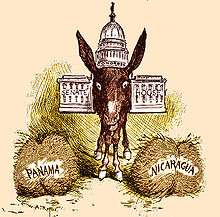Voting paradox
The voting paradox (also known as Condorcet's paradox or the paradox of voting) is a situation noted by the Marquis de Condorcet in the late 18th century, in which collective preferences can be cyclic (i.e., not transitive), even if the preferences of individual voters are not cyclic. This is paradoxical, because it means that majority wishes can be in conflict with each other. When this occurs, it is because the conflicting majorities are each made up of different groups of individuals.
Thus an expectation that transitivity on the part of all individuals' preferences should result in transitivity of societal preferences is an example of a fallacy of composition.
Example
Suppose we have three candidates, A, B, and C, and that there are three voters with preferences as follows (candidates being listed left-to-right for each voter in decreasing order of preference):
| Voter | First preference | Second preference | Third preference |
|---|---|---|---|
| Voter 1 | A | B | C |
| Voter 2 | B | C | A |
| Voter 3 | C | A | B |
If C is chosen as the winner, it can be argued that B should win instead, since two voters (1 and 2) prefer B to C and only one voter (3) prefers C to B. However, by the same argument A is preferred to B, and C is preferred to A, by a margin of two to one on each occasion. Thus the society's preferences show cycling: A is preferred over B which is preferred over C which is preferred over A. A paradoxical feature of relations between the voters’ preferences described above is that although the majority of voters agree that A is preferable to B, B to C, and C to A, all three coefficients of rank correlations between the voters’ preferences are negative (namely, -.5), as calculated with Spearman's rank correlation coefficient formula designed by Charles Spearman much later.[1]
Necessary condition for the paradox
Suppose that x is the fraction of voters who prefer A over B and that y is the fraction of voters who prefer B over C. It has been shown[2] that the fraction z of voters who prefer A over C is always at least (x + y – 1). Since the paradox (a majority preferring C over A) requires z < 1/2, a necessary condition for the paradox is that
Implications
When a Condorcet method is used to determine an election, the voting paradox of cyclical societal preferences implies that the election has no Condorcet winner: no candidate who can win a one-on-one election against each other candidate. The several variants of the Condorcet method differ on how they resolve such ambiguities when they arise to determine a winner. Note that there is no fair and deterministic resolution to the trivial example given earlier because each candidate is in an exactly symmetrical situation.
Situations having the voting paradox can cause voting mechanisms to violate the axiom of independence of irrelevant alternatives—the choice of winner by a voting mechanism could be influenced by whether or not a losing candidate is available to be voted for.
One important implication of the possible existence of the voting paradox in a practical situation is that in a two-stage voting process, the eventual winner may depend on the way the two stages are structured. For example, suppose the winner of A versus B in the open primary contest for one party's leadership will then face the second party's leader, C, in the general election. In the earlier example, A would defeat B for the first party's nomination, and then would lose to C in the general election. But if B were in the second party instead of the first, he would defeat C for that party's nomination, and then would lose to A in the general election. Thus the structure of the two stages makes a difference for whether A or C is the ultimate winner.
Likewise, the structure of a sequence of votes in a legislature can be manipulated by the person arranging the votes, to ensure a preferred outcome.
See also
- Arrow's impossibility theorem
- Discursive dilemma
- Gibbard–Satterthwaite theorem
- Independence of irrelevant alternatives
- Instant-runoff voting
- Kenneth Arrow, Section 1 with an example of a distributional difficulty of intransitivity + majority rule
- Nakamura number
- Smith set
References
- ↑ Poddiakov, A., & Valsiner, J. (2013). Intransitivity cycles and their transformations: How dynamically adapting systems function. In L. Rudolph (Ed.), Qualitative Mathematics for the Social Sciences: Mathematical Models for Research on Cultural Dynamics (pp. 343–391). Abingdon, NY: Routledge.
- ↑ Silver, Charles. "The voting paradox", The Mathematical Gazette 76, November 1992, 387–388.
Further reading
- Garman, M. B.; Kamien, M. I. (1968). "The paradox of voting: Probability calculations". Behavioral Science. 13 (4): 306–316. doi:10.1002/bs.3830130405.
- Niemi, R. G.; Weisberg, H. (1968). "A mathematical solution for the probability of the paradox of voting". Behavioral Science. 13 (4): 317–323. doi:10.1002/bs.3830130406.
- Niemi, R. G.; Wright, J. R. (1987). "Voting cycles and the structure of individual preferences". Social Choice and Welfare. 4 (3): 173–183. doi:10.1007/BF00433943. JSTOR 41105865.
